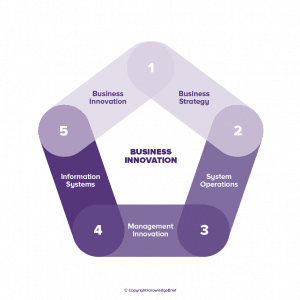“Learn the rules like a pro, so you can break them like an artist”
Pablo Picasso
Back in May, Fast Company revealed its 2019 list of the 50 best workplaces for innovators, a list that tried to acknowledge the businesses that cultivate big ideas and encourage experimentation. The list is a mixture of obvious choices (like Amazon and Mozilla) to true surprises (who would’ve expected to see an Australian-based digital marketing agency?) but, ultimately, all of the included companies deserve to be in it.
Why? Because all of those companies truly honor what anyone thinks of when imagining an innovative workplace. In other words, these companies go after unusual projects pushed by their own employees, embrace failures as part of the learning process, and facilitate the collaboration between teams to let ideas thrive.
In a certain sense, what unites all of the companies in Fast Company’s list is that they all seemingly ignore the traditional operational rules that might have led them to grow in the first place. It feels like the quote “Learn the rules like a pro, so you can break them like an artist”, attributed to famous painter Pablo Picasso, is the engine that moves the innovation within these companies.
In an ever-changing scenario with an increasing presence of digital tools and emerging technologies, being innovative means to be flexible enough to go with the flow and change course rapidly to stay relevant. However, is this kind of rule-breaking innovation possible when standardized processes and disciplined approaches are needed to provide peak operational performance? Aren’t those things mutually exclusive?
It certainly feels that way but, as the 50 companies from that list show, is possible to combine both approaches to get the most out of both.
New rules for a new digital era
The digital age, with its breakneck speed and constant evolution, is challenging businesses of all sizes and across industries to keep up. That context is ripe for startups to blossom. That’s because they don’t have to fight with a company history that’s hanging over their innovative ideas. Since they are coming out of the blue, they can define themselves in any way they want, thus becoming the disruptors.
Of course, there’s also the other side of the story – incumbent businesses that are struggling to stay in the game. It’s in this struggle that the need for a new approach is seen best. Since technological development demands fast adaptation from companies, the bigger ones that are in the process of digitizing themselves don’t show timely reactions that accommodate them in the face of new challenges.
The problem is laid out for all to see – while companies will need to adopt a digital mentality that takes the benefits from digital tools, they’ll need to do so in an organized way that secures a successful implementation. So, how do they do to transform themselves digitally, allowing for flexibility and innovation but also keeping a level of accountability and responsibility? In other words, if innovating means that companies need to break their own rules, how do they prevent hell from breaking loose?
As contradictory as all it sounds, it’s quite possible to have processes, plans, and strategies that secure the business’s future in the long run but that also allow employees to innovate and thrive. For that to happen, the company execs need to foster a new approach to doing business, allowing for the creation of a new set of rules that don’t come from the top-dow but that is created horizontally. Basically, they need to break the rules that made them successful in the first place.
Permission to fail
In a very interesting article about this topic, Jeanne Ross, a research scientist for MIT’s Center for Information Systems Research, says that companies can do three things to get started:
- Distinguish digitization from digital initiatives.
- Give digital business leaders space to invent new rules and metrics.
- Identify and train new leaders.
The first item is crucial for the successful adoption of an innovative atmosphere in the workplace. It means that businesses need to understand the difference between the technologies that are driving the current landscape (everything from data science to artificial intelligence) and the initiatives in place to make those technologies work for business purposes (reliability, predictability, security, visibility).
The important thing, according to Ross, is “not to let digitization efforts be the sole application of digital technologies.” In other words, the possibilities brought by new emerging technologies (the innovation that can come out of them) shouldn’t be bound by the tight performance metrics of traditional initiatives (such as cost savings and customer happiness). Though those technologies can certainly be measured with those metrics, they shouldn’t be always used to define their success or failure.
Instead, it’s important to understand that emerging technologies can bring new data-rich and innovation-driven propositions, from new business opportunities to improved insights. For that to happen, a company has to let those metrics aside and forget about the traditional rules for a while. In their place, businesses have to put experimentation as a major value. Since it’s impossible to guarantee that a new product, service or feature will be loved by customers, it’s important to let room for testing – and for failure.
Sounds hard to get that in reality? It is. That’s why it is important to provide a safe and clear space for people to experiment and innovate. That’s why Ross’s second point is to “give digital leaders space.” In other words, people within a company have to have permission to fail, to try and try again to understand what might work in an ever-changing context, historical business rules be damned.
By doing that, businesses can start figuring out what works and what not, generating new revenues along the way while also paving the way for the business model of the future. Of course, that can only take place with the right people leading the way. That brings us to Ross’ final point – having leaders with a fresh mentality who understand the new way of doing things is a must for the approach to work at all.
Traditional leaders find themselves limited by their fear to break the rules or by their bias towards methods that might contradict their experience. That’s the reason why companies looking to innovate should also break the rules when choosing their new leaders, forgetting for a minute about traditional skills and focusing on other important abilities, such as creativity, communication, focus, and lack of fear.
Innovation today
Among the companies listed by Fast Company, there’s one that many would have guessed as an innovative business – Amazon. The tech giant shared a blog post after being included in the list in which it revealed some of its “secrets” for being considered as one of the best workplaces for innovators. By only scanning it, anyone can see that all those secrets align perfectly with all of the above: empower people, embrace failure, foster creativity, and cultivate innovators.
For traditionalists, this might seem strange, as a lot of businesses grew big by letting the execs make all the decisions. However, those times are now gone – and rules have changed. That’s why anyone trying to innovate should start breaking them. That’s not to say they should become anarchists, but that businesses should make new rules for new times, rules that feel more like frames of references rather than established laws.
By allowing flexibility and experimentation, and by fostering a culture of embracing failure, modern companies can finally start innovating and move along with the current tides.







